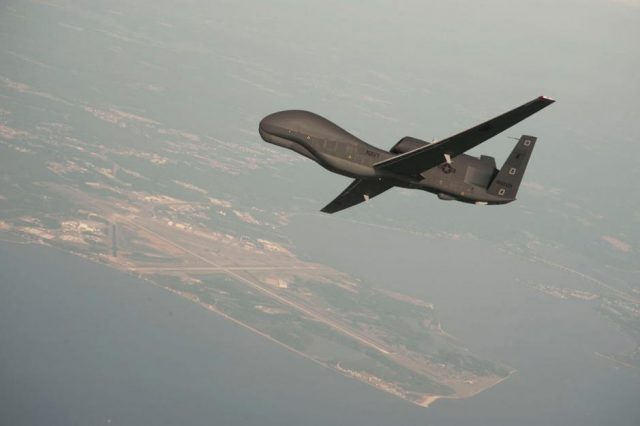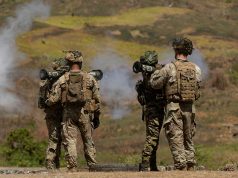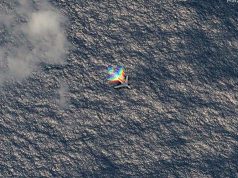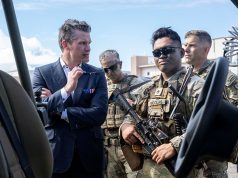
WASHINGTON — The Trump administration is nearing completion of new “Buy American” rules to make it easier to sell U.S.-made military drones overseas and compete against fast-growing Chinese and Israeli rivals, senior U.S. officials said.
While President Donald Trump’s aides work on relaxing domestic regulations on drone sales to select allies, Washington will also seek to renegotiate a 1987 missile-control pact with the aim of loosening international restrictions on U.S. exports of unmanned aircraft, according to government and industry sources.
At home, the U.S. administration is pressing ahead with its revamp of drone export policy under heavy pressure from American manufacturers and in defiance of human rights advocates who warn of the risk of fueling instability in hot spots including the Middle East and South Asia.
The changes, part of a broader effort to overhaul U.S. arms export protocols, could be rolled out by the end of the year under a presidential policy decree, the administration officials told Reuters on condition of anonymity.
The aim is to help U.S. drone makers, pioneers in remote-controlled aircraft that have become a centerpiece of counterterrorism strategy, reassert themselves in the overseas market where China, Israel and others often sell under less-cumbersome restrictions.
Simplified export rules could easily generate thousands of jobs, but it’s too early to be more specific, said Remy Nathan, a lobbyist with the Aerospace Industry Association. The main beneficiaries would be top U.S. drone makers General Atomics, Boeing, Northrop Grumman, Textron and Lockheed Martin.
“This will allow us to get in the game in a way that we’ve never been before,” said one senior U.S. official.
‘Buy American’ agenda
Regulations are expected to be loosened especially on the sale of unarmed intelligence, surveillance and reconnaissance drones, the most sophisticated of which carry high-resolution cameras and laser-guided targeting systems to aid missiles fired from warplanes, naval vessels or ground launchers.
Deliberations have been more complicated, however, on how to alter export rules for missile-equipped drones like the Predator and Reaper. Hunter-killer drones, which have essentially changed the face of modern warfare, are increasingly in demand and U.S. models considered the most advanced.
The push is not only part of Trump‘s “Buy American” agenda to boost U.S. business abroad but also reflects a more export-friendly approach to weapons sales that the administration sees as a way to wield influence with foreign partners, the senior official said.
Under a draft of the new rules, a classified list of countries numbering in double digits would be given more of a fast-track treatment for military drone purchases, a second senior official said. The favored group would include some of Washington’s closest NATO allies and partners in the “Five Eyes” intelligence alliance: Britain, Australia, Canada and New Zealand, according to the industry source.
Rachel Stohl, director of the conventional defense program at the Stimson Center in Washington, said if U.S. drone export rules become too lenient, they could give more governments with poor human rights records the means to “target their own civilians.”
Trump’s predecessor, President Barack Obama, revised the policy for military drone exports in 2015. But U.S. manufacturers complained it was still too restrictive compared with main competitors China and Israel.
U.S. drone makers are vying for a larger share of the global military drone market. Even before the coming changes, the Teal Group, a market research firm, has forecast sales will rise from $2.8 billion in 2016 to $9.4 billion in 2025.
Linden Blue, CEO of privately held General Atomics, the U.S. leader in military drones, visited the White House recently to lobby for his industry, a person familiar with the discussions said.
Among the U.S. changes will be a formal reinterpretation of the “presumption of denial,” a longstanding obstacle to most military drone sales that would make it easier and faster to secure approval, the officials said.
Britain and, only recently, Italy are the only countries that had been allowed to buy armed U.S. drones.
A long-delayed $2 billion sale to India of General Atomics’ Guardian surveillance drones finally secured U.S. approval in June. But New Delhi’s request for armed drones has stalled.
A major hurdle to expanded sales of the most powerful U.S. drones is the Missile Technology Control Regime, or MTCR, a 1987 accord signed by the United States and 34 other countries, which set rules for the sale and purchase of missiles.
It categorizes drones with a range greater than of 185 miles (300 kilometers) and a payload above 1,100 pounds (500 kilograms) as cruise missiles, requiring extremely tight import/export controls. To gain an international stamp of approval for the relaxed U.S. export rules, U.S. officials want the MTCR renegotiated.
State Department officials attending an annual meeting of the missile-control group in Dublin next week will present a “discussion paper” proposing that sales of drones — which did not exist when the agreement was created — be treated more leniently than the missile technology that the MTCR was designed to regulate, according to a U.S. official and industry sources.
There is no guarantee of a consensus. Russia, which has NATO members along its borders, could resist such changes, the U.S. official said.
China and Israel
China, which is not an MTCR signatory, has pushed ahead with drone sales to some countries with close ties to Washington, such as Iraq, Saudi Arabia and Nigeria, but which have failed to pass U.S. regulatory muster.
Chinese models such as the CH-3 and CH-4 have been compared to the Reaper but are much cheaper. U.S. officials said Beijing sells them with few strings attached.
The Chinese foreign ministry insists it takes a “cautious and responsible attitude” to military drone exports.
Israel, which is outside the MTCR but has pledged to abide by it, competes with U.S. manufacturers on the basis of high-tech standards. But it will not sell to neighbors in the volatile Middle East. Israel sold $525 million worth of drones overseas in 2016, according defense ministry data.
U.S. drone makers and their supporters within the administration contend that other countries are going to proliferate drones, so they should not be left behind.









